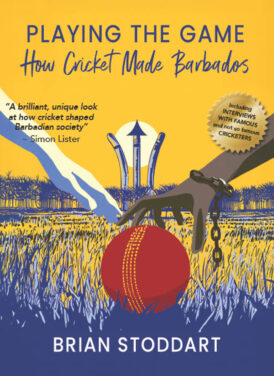Playing the Game: How Cricket Made Barbados
Martin Chandler |Published: 2025
Pages: 358
Author: Stoddart, Brian
Publisher: Brickwork Media
Rating: 4 stars

I have read books about the history of cricket in the West Indies before. They are an interesting selection and, largely, concentrate on cricket. Their problem, which this splendid book from Brian Stoddart underlines, is that the West Indies, being a collection of individual nations, are very difficult to treat with a broad brush other than in relation to cricket.
I am as guilty as many at overlooking this simple fact, and for generalising where I should not do so and, as a consequence I have learnt a valuable lesson from reading Playing the Game. It is a book that has taught me a great deal about the history of Barbados, although I should perhaps stress it is not intended to be a definitive history of the country.
The book is also something of an autobiography. Stoddart, born in New Zealand but based now in Australia, is an academic and has studied, researched and written widely on sports history. Amongst his extensive oeuvre are a couple of books on the ‘Bodyline’ series of 1932/33, but I believe this is his first cricket book since the mid 1980s.
And it was around that time when Stoddart was given six months paid leave to go and study in Barbados, and he took another six months unpaid, so Playing the Game has had a long gestation period. During his time on the island Stoddart played plenty of cricket too, eventually deciding to play for Maple.
That there was for many years a class and colour structure to club cricket on Barbados I certainly knew, but only in outline. As a result of reading Playing the Game it is something I do now fully understand. As he looks around with, in his case a full range of options, Stoddart tells the stories of each of the major clubs with reference to those individuals who played for them, and indeed those who did not.
Playing cricket does, of course, lead to talking cricket, and Stoddart clearly spent much of his time in Barbados doing just that. And not just with his Maple teammates and their opponents. Barbados is a small island and in those days the game had a huge following and conversations with the likes of Everton Weekes, Garry Sobers, Clyde Walcott, Charlie Griffith and Tony Cozier as well as many others provide some of the material for Playing the Game.
The length of the bibliography is testament to the number of sources that Stoddart has consulted in order to establish the political, economic, cultural, cricketing and social history of Barbados. But it is the voices of the great and the good of the Bajan populace of the mid 1980s that provide the glue that holds Stoddart’s book together.
Fascinating stories abound throughout Playing the Game. One from long ago is that of Fitz Hinds, one of the first West Indian professionals and, more than three quarters of a century later, another is that of a man who, as Hinds had, had to leave Barbados to earn a living. He is the ultimately tragic figure of Essex and West Indies all-rounder Keith Boyce. If Stoddart is casting his eye around for something to do in the future biographies of either of them, or preferably both, would be very welcome additions to the game’s literature.
A special case is, of course, Sobers who many, this reviewer included, consider to be the greatest cricketer to have played the game. It is only to be expected that he should be revered throughout the tiny island nation that produced him, although the most interesting reference to him deals with the one occasion when he did make a mistake, in travelling to the then Rhodesia for a double wicket contest in 1969.
The final chapter of the book is titled Past and Present and, after his year in Barbados, it is now four decades since Stoddart left the Caribbean. Having greatly enjoyed his stay in the country there have, naturally, been people and places to catch up with and in the twenty first century he is able to confirm that enthusiasm for the game in the country is not what it once was. Sadly he has no answers to the current malaise, but at least he does not seem to take the view that the game’s decline is terminal.
In any event as an account of a population that is around half the size of that of Cornwall, yet has produced enough top class cricketers to produce an all time eleven that could compete on even terms with anybody Playing the Game is highly recommended.






Leave a comment